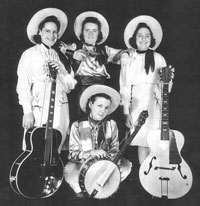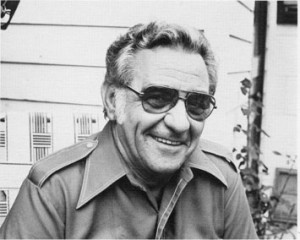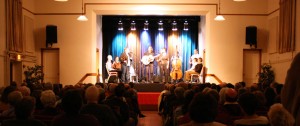reprinted from Le forum, Franco American Centre, UMaine/Orono: June 1998, © Donna Hébert
As I ponder what the music I play means to me, I know that, having heard my mother’s music and seen her family’s musical house parties as a child, I would not feel settled or satisfied until I had made it a large part of my adult life

My mother’s French immigrant family is very musical. While they gave up their language in an effort to assimilate and avoid discrimination, the music remained as a viable outlet for culture. Five of my her seven siblings played, as did both my maternal grandparents – fiddle, piano, tenor banjo, accordion, guitar, mandolin. My mother sang and played the tenor banjo in bands in the thirties and forties, with her sister, Theresa. Their strict father fetched them home from Boston because, “nice girls didn’t go live in the city and become musicians.” They were good pickers too, and did a lot of harmony yodeling in their act. I recall my mom trying to teach me to yodel before my voice ever broke! She played tunes on the banjo, as well as backing up songs.
So, as a child, while I didn’t play “Franco-American music,” I listened and learned technique and other musical skills. At 22, I was re-introduced to fiddle music through Dudley Laufman’s Canterbury Country Dance Orchestra, and what should I find but a re-creation (on a larger scale – not the kitchen but a town hall) of my grandmother’s kitchen soirées. I was hooked. About a third of the tunes had French names, but it wasn’t quite what I remembered.

Then, after a year or so of sitting in at Dudley’s dances, I travelled to Barre, Vermont to see a fiddle contest at the invitation of my mother’s cousin, Clem Myers, who founded the Northeast Fiddlers’ Association. When I walked in, they were setting up for a band to play. Then Louis Beaudoin of Burlington, VT sat down on the stage, started clogging with his feet and began to play with members of his family. I was transported back to my grandmother’s kitchen junkets. I knew what I wanted. And I was beginning to know who I was.
Later that year, at the French Club in Waltham, MA, I met Gerry Robichaud, an Acadian fiddler from Waltham MA, who’d come to the “Boston States” from Moncton, New Brunswick in the sixties. I heard some of my uncle’s fiddling in Gerry’s playing, which had a smoother, more rolling sound than Louis’ Québécois swing. I wanted all of it! The Acadian and the Québécois sounds made me happy, made me feel “at home” in the music. They excited me. I loved Irish and Scottish music, and New England dance tunes, but the French music made me grin like a fool, and I wanted to play it with the swing, the rhythms that came so naturally to Louis Beaudoin. With the French tunes, I was home.
I loved Louis and Gerry as people and as musicians. Both the Beaudoin and Robichaud families welcomed me into their homes. In fact, it was like going as a child to visit on Sunday, which we’d always done. We’d go take a ride and drop in on a relative. Sometimes there would be music, always someone would be playing whist or gin rummy. Everyone brought food and news and shared both. So, woven in with the food and the visits with members of the Beaudoin family each time I was there (Louis had five daughters!) was the most incredible music. “Hey Donna, you know this one?” he’d say, and be off on another great tune. I’d scramble to put down my food and drink, grab my fiddle and try to follow him.

I came back to Louis Beaudoin’s soirées whenever I could until his death. And by then, I had also recorded an album for Alcazar with Gerry Robichaud, his brother Bobby Robichaud, and Tony Parkes. Working with Gerry to prepare for this album gave me a lot of time to watch and listen to him play. His groove was different, smoother, a little faster. And his tunes were terrific! So, after a year and a half of playing with Gerry every week, his style had begun to creep into mine, which was fine by me. It’s still there in my playing, as is “le swing” that I got from Louis Beaudoin, and that old fiddling sound that I first heard in my grandmother’s kitchen.
So what does all this say about the music that I play and what it means to me? Well, I have chosen to make fiddle music, and particularly Franco-American fiddle music – its performance, documentation and transmission through teaching – my life’s work. And if this music is so essential to the lives of so many – myself, Josée Vachon, Gerry Robichaud, Joe Cormier, Louis Beaudoin, and so many others, then it is indeed vibrantly alive. The fact that young people are learning about their Franco-American cultural heritage through music, and that they are as excited about the songs, tunes and dances as I was then and still am now, reassures me that our culture lives.
Printed June 1998 in Le Forum, The Franco American Center, University of Maine at Orono